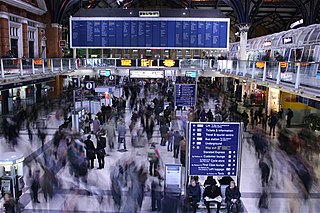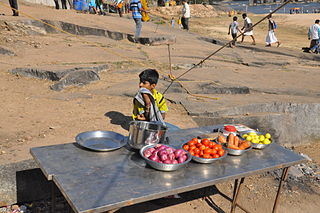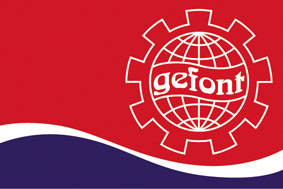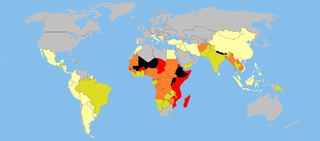
The International Labour Organization (ILO) is a United Nations agency whose mandate is to advance social and economic justice through setting international labour standards. Founded in October 1919 under the League of Nations, it is the first and oldest specialised agency of the UN. The ILO has 187 member states: 186 out of 193 UN member states plus the Cook Islands. It is headquartered in Geneva, Switzerland, with around 40 field offices around the world, and employs some 2,700 staff from over 150 nations, of whom 900 work in technical cooperation programmes and projects.
Labour law mediates the relationship between workers, employing entities, trade unions and the government. Collective labour law relates to the tripartite relationship between employee, employer and union. Individual labour law concerns employees' rights at work also through the contract for work. Employment standards are social norms for the minimum socially acceptable conditions under which employees or contractors are allowed to work. Government agencies enforce labour law.

Peonage, also known as debt slavery or bonded labour, is the pledge of a person's services as security for the repayment for a debt or other obligation, where the terms of the repayment are not clearly or reasonably stated, and the person who is holding the debt thus has some control over the laborer. Freedom is assumed on debt repayment. The services required to repay the debt may be undefined, and the services' duration may be undefined, thus allowing the person supposedly owed the debt to demand services indefinitely. Debt bondage can be passed on from generation to generation.

A sweatshop or sweat factory is a crowded workplace with very poor, socially unacceptable or illegal working conditions. The work may be difficult, dangerous, climatically challenging or underpaid. Workers in sweatshops may work long hours with low pay, regardless of laws mandating overtime pay or a minimum wage; child labor laws may also be violated. The Fair Labor Association's "2006 Annual Public Report" inspected factories for FLA compliance in 18 countries including Bangladesh, El Salvador, Colombia, Guatemala, Malaysia, Thailand, Tunisia, Turkey, China, India, Vietnam, Honduras, Indonesia, Brazil, Mexico, and the US. The U.S. Department of Labor's "2015 Findings on the Worst Forms of Child Labor" found that "18 countries did not meet the International Labour Organization's recommendation for an adequate number of inspectors."

United Kingdom labour law regulates the relations between workers, employers and trade unions. People at work in the UK benefit from a minimum charter of employment rights, which are found in various Acts, Regulations, common law and equity. This includes the right to a minimum wage of £8.91 for over-25-year-olds under the National Minimum Wage Act 1998. The Working Time Regulations 1998 give the right to 28 days paid holidays, breaks from work, and attempts to limit excessively long working hours. The Employment Rights Act 1996 gives the right to leave for child care, and the right to request flexible working patterns. The Pensions Act 2008 gives the right to be automatically enrolled in a basic occupational pension, whose funds must be protected according to the Pensions Act 1995.
Labor rights or workers' rights are both legal rights and human rights relating to labor relations between workers and employers. These rights are codified in national and international labor and employment law. In general, these rights influence working conditions in relations of employment. One of the most prominent is the right to freedom of association, otherwise known as the right to organize. Workers organized in trade unions exercise the right to collective bargaining to improve working conditions.

The term ethical trade first gained currency in the mid-1990s, where it was used as a term for socially responsible sourcing. Ethical trade addresses the ethical aspects of organisations including worker welfare, agricultural practice, natural resource conservation, and sustainability of the environment. Since then, numerous multinational organisations have adopted ethical trade policies by outsourcing to auditing companies to monitor the conditions of workers in their supply chains. The leading alliance of these companies, trade unions and non-governmental organisations is the Ethical Trading Initiative. to support business

The General Federation of Nepalese Trade Unions (GEFONT) is a confederation of 20 national trade union federations. It is politically tied to the Communist Party of Nepal. GEFONT declares its goal to be "Socialism for the dignified working-class and prosperous life".
Kamaiya and Kamlari were two traditional systems of bonded labour practised in the western Terai of Nepal. Both were abolished after protests, in 2000 and 2006 respectively.
A Haliya is an agricultural bonded labourer who works on another person's land. The literal meaning of Haliya is "one who ploughs". Haliyas can be found throughout Nepal. But the Haliya system in the far western hilly part of Nepal is considered a bonded labour system.
Labour in India refers to employment in the economy of India. In 2020, there were around 501 million workers in India, the second largest after China. Out of which, agriculture industry consist of 41.19%, industry sector consist of 26.18% and service sector consist 32.33% of total labour force. Of these over 94 percent work in unincorporated, unorganised enterprises ranging from pushcart vendors to home-based diamond and gem polishing operations. The organised sector includes workers employed by the government, state-owned enterprises and private sector enterprises. In 2008, the organised sector employed 27.5 million workers, of which 17.3 million worked for government or government owned entities.

Human trafficking is the trade of humans for the purpose of forced labour, sexual slavery, or commercial sexual exploitation for the trafficker or others. This may encompass providing a spouse in the context of forced marriage, or the extraction of organs or tissues, including for surrogacy and ova removal. Human trafficking can occur within a country or trans-nationally. Human trafficking is a crime against the person because of the violation of the victim's rights of movement through coercion and because of their commercial exploitation. Human trafficking is the trade in people, especially women and children, and does not necessarily involve the movement of the person from one place to another.
Indian labour law refers to laws regulating labour in India. Traditionally, Indian government at federal and state level have sought to ensure a high degree of protection for workers, but in practice, this differs due to form of government and because labour is a subject in the concurrent list of the Indian Constitution.

In 2011, the national census of India found the total number of child labourers, aged [5–14], to be at 10.1 million, out of the total of 259.64 million children in that age group. The child labour problem is not unique to India; worldwide, about 217 million children work, many full-time.
Human trafficking in Nepal is a growing criminal industry affecting multiple other countries beyond Nepal, primarily across Asia and the Middle East. Nepal is mainly a source country for men, women and children subjected to the forced labor and sex trafficking. U.S. State Department's Office to Monitor and Combat Trafficking in Persons placed the country in "Tier 2" in 2017.
Child labour in Pakistan is the employment of children for work in Pakistan, which causes them mental, physical, moral and social harm. The Human Rights Commission of Pakistan estimated that in the 1990s, 11 million children were working in the country, half of whom were under age ten. In 1996, the median age for a child entering the work force was seven, down from eight in 1994. It was estimated that one quarter of the country's work force was made up of children.

Ramjee Kunwar is a Nepal Trade Union Congress-Independent (NTUCI) leader, Senior Vice President of NTUCI and executive member of Nepali Congress Party. He was also the former Vice President and Secretary of NTUCI and currently Acting president.
International labour law is the body of rules spanning public and private international law which concern the rights and duties of employees, employers, trade unions and governments in regulating the workplace. The International Labour Organization and the World Trade Organization have been the main international bodies involved in reforming labour markets. The International Monetary Fund and the World Bank have indirectly driven changes in labour policy by demanding structural adjustment conditions for receiving loans or grants. Issues regarding Conflict of laws arise, determined by national courts, when people work in more than one country, and supra-national bodies, particularly in the law of the European Union, has a growing body of rules regarding labour rights.

The All Nepal Federation of Trade Unions (ANTUF) is a national trade union center representing workers in Nepal. The Federation had its origins in the Nepalese Civil War and was created by activists from the Communist Party of Nepal (Maoist). Following the peace accords in 2006, the ANTUF was founded in 2007. The ANTUF is made up of 35 affiliated organisations. In January 2019, following the creation of the Nepal Communist Party, talks commenced for a merger between the ANTUF and the General Federation of Nepalese Trade Unions (GEFONT).
The haruwa–charuwa system is a forced-labour system based on debt bondage, prevalent in the agricultural sector of the eastern Terai region in Nepal. Haruwa means "forced tiller" and are usually adult males, while charuwa means "forced cattle-herder" and are usually women and children. The victims of this bonded labour system are usually dalit families, most commonly from the Musahar caste. Due to landlessness and poverty, they are forced into service of landowner families under slavery-like conditions. The haruwa–charuwa system is similar to the Haliya and Kamaiya systems of western Nepal.













